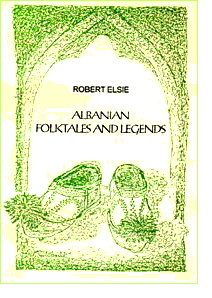|
Robert Elsie
Albanian folktales and legends
Selected and translated from the Albanian
Naim Frashëri, Tirana 1994
223 pp.

 INTRODUCTION INTRODUCTION
Folk tales and legends are still very
much alive in the mountains of Albania, a land of haunted history.
They are recited in the evenings after a day's work or out in
the fields, are learned by heart and pass, as if immortal, from
one generation to the next. Whose imagination could not be captured
by the cunning of the Scurfhead, by the demands of the Earthly
Beauty, by the heroic feats of Mujo and Halil or by the appearance
of a fiery Kulshedra in the forest?
The fundamental theme of Albanian folk
tales, as no doubt of folk tales everywhere, is the struggle
between good and evil, a reflection of social values as we perceive
them. The cautious reader may rest assured from the start that
in the fantastic world of Albanian folk literature the good always
win out.
Oral literature is known to preserve
many archaic elements. Albanian folk tales reveal not only a
number of oriental features from the centuries when Albania formed
an integral part of the Ottoman Empire but indeed also the occasional
trace of the ancient world of Greco-Roman mythology. Pashas and
dervishes abound in an otherwise eminently European context.
The evident patriarchal structure in the tales and the passive,
secondary roles attributed to female characters reflect Albania's
traditionally Moslem society. In the first half of the twentieth
century, about 70% of the Albanian population was Moslem, 20%
Orthodox and 10% Catholic.
Yet despite their oriental background
and the remoteness of Albanian culture, one of the last in Europe
to withstand the onslaught of our high-tech monoculture, many
of the tales will have a surprisingly familiar ring to the Western
reader.
Albanian folk tales were first recorded
in the middle of the nineteenth century by European scholars
such as Johann Georg von Hahn (1854), the Austrian consul in
Janina (Ioannina), Karl H. Reinhold (1855) and Giuseppe Pitrè
(1875). The next generation of scholars to take an interest in
the collection of Albanian folk tales were primarily philologists,
among them well-known Indo-European linguists concerned with
recording and analysing a hitherto little known European language:
Auguste Dozon (1879, 1881), Jan Jarnik (1883), Gustav Meyer (1884,
1888), Holger Pedersen (1895), Gustav Weigand (1913) and August
Leskien (1915).
The nationalist movement in Albania in
the second half of the nineteenth century, the so-called Rilindja
period, gave rise to native collections of folklore material
such as the 'Albanian Bee' (Albanike melissa / Belietta sskiypetare)
by Thimi Mitko (1878), the 'Albanian Spelling Book' (Albanikon
alfavetarion / Avabatar arbëror) by the Greco-Albanian
Anastas Kullurioti (1882) and the 'Waves of the Sea' (Valët
e Detit) by Spiro Dine (1908). In the last thirty years, much
field work has been done by the Institute of Folk Culture in
Tirana and by the Institute of Albanian Studies in Prishtina,
which have published numerous collections of folk tales and legends.
Unfortunately, very little of this substantial material has been
translated into other languages.
The only substantial collections of Albanian
folk tales to have appeared in English up to the present, as
far as I am aware, are Tricks of women and other Albanian
tales by Paul Fenimore Cooper (New York 1928), which was
translated from the collections of Dozon and Pedersen, and Albanian
wonder tales by Post Wheeler (London 1936). The present volume
of Albanian tales endeavours to be as faithful as possible in
style and content to the original Albanian texts which were recorded
from word of mouth in a relatively unelaborate code.
Included in this collection are not only
folk tales but prose versions of a selection of well-known Albanian
legends (based originally on historical or mythological events
and figures). The adventures of Mujo and Halil and their band
of mountain warriors are still told and indeed sung in epic verse
in the northern Albanian mountains, and the exploits of the great
Scanderbeg, the Albanian national hero who freed large parts
of the country from Turkish rule in the fifteenth century, are
recounted everywhere Albanians gather, as if events five centuries
old had taken place yesterday.
It remains for me to thank the many people
who have assisted me in this project, among whom the late Qemal
Haxhihasani of the Institute of Folk Culture (Tirana), staff
members of the Institute of Linguistics and Literature (Tirana)
and of the Institute of Albanian Studies (Prishtina), as well
as Barbara Schultz (Ottawa) for her kind revision of the manuscript.
Robert
Elsie
Eifel mountains, Germany

TABLE OF CONTENTS
- Introduction
- Albanian folk tales
The boy and the Earthly Beauty
The scurfhead
The three friends and the Earthly Beauty
The three brothers and the three sisters
The youth and the maiden with stars on their foreheads and crescents
on their breasts
The shoes
The girl who became a boy
The maiden in the box
The tale of the youth who understood the language of the animals
The Stirrup Moor
The king's daughter and the skull
The bear and the dervish
The snake and the king's daughter
Gjizar the nightingale
Half Rooster
The boy with no name
The barefaced man and the Pasha's brother
The foolish youth and the ring
The princess of China
The jealous sisters
The grateful snake and the magic case
The maiden who was promised to the sun
- Albanian legends
Mujo's strength
Mujo and the Zanas
Halil's marriage
Mujo and Halil visit the Sultan
Mujo avenges Halil's death
Gjergj Elez Alia
Aga Ymer of Ulcinj
Scanderbeg and Ballaban
Shega and Vllastar
Rozafat Castle
- Notes
- Bibliography

|
 INTRODUCTION
INTRODUCTION